The Contested Murder of Latasha Harlins by Stevenson Brenda

Author:Stevenson, Brenda
Language: eng
Format: epub
Tags: Justice, Gender, and the Origins of the LA Riots
Publisher: Oxford University Press, USA
Published: 2013-10-15T00:00:00+00:00
Jews, Blacks, and Asian Americans
The Jewish experience with persons of African descent within the United States extends back to the colonial period, where it mimicked that typically attributed to whites and blacks. As Hasia Diner notes, Jews throughout the colonies owned slaves and participated in the slave trade. Moreover, ânothing in their letters, wills and other writings indicat[ed] any ambivalence about the practice; indeed, following this fashion helped them to be more like their neighbors.â136 Unlike Europe, where class, religion, and race were dividing elements, the single most important badge worn in the colonies, and later in the nation, was that of color. The lighter oneâs color, the more privileges afforded one. As such, blacks found themselves at the bottom of social (and judicial) structures. Jews during the colonial era, on the other hand, benefited from their white skin. Diner adds, for example, that âin America, to be âwhiteâ meant to be free, and not being white meant enduring enslavement.â As such, âJews in the colonies had an asset that served them well: they were white. They no longer bore the burden of being the stigmatized group whom others reviled and oppressed.â137 Historian Cheryl Greenberg agrees, concluding that â(European) Jews in the United States have benefitted from having white skin, even when they rejected a white identity, and that whiteness has informed their politics more than they recognize.â138 Still, Jews were not universally thought of as white. This was particularly so when culture, especially religion and language, carried great social significance. Moreover, diversity within their own ranks later in US history (Hasidic Orthodox, non-Hasidic Orthodox, Reformed, Conservative, and Reconstructionist) created internal hierarchies that sometimes were externally exploited and even racialized.139
Historically, blacks, as well as whites and Asian/Asian-Americans, have related to Jews both as whites and nonwhites, friend and foe. Jews, themselves, struggled with this dual identity in the United Statesâof being Jewish and white, segregated or assimilated, accepted or rejected, living either in the mainstream or on the margins, or both, concurrently. Of course, their changing relationships with blacks, Asians, and other racialized minorities depended in large measure on their own perceived racial/ethnic identity, both as part of a group and as individuals at a specific time and place.140 As whites, blacks perceived Jews as oppressive and exploitative, greeting them with animosity and, sometimes, anti-Semitism.141 This was particularly so when Jews exercised inordinate power vis à vis blacks as landlords and employers. As nonwhites, on the other hand, blacks have recognized the hardships Jews faced in Europe, America, and elsewhere, thus fostering a kind of kinship. They also have much appreciated the willingness of some in Jewish communities to promote human and civil rights across color, class, and regional lines. The history between the two groups, therefore, is a complex one.
During the colonial and antebellum eras, equality before the law, or in the law, between the two groups was not possible. Jews could be citizens; blacks could not. Jews were free; the vast majority of blacks were enslaved. After the Civil War, Jews again were distinguishable from blacks in law and treatment.
Download
This site does not store any files on its server. We only index and link to content provided by other sites. Please contact the content providers to delete copyright contents if any and email us, we'll remove relevant links or contents immediately.
| Anthropology | Archaeology |
| Philosophy | Politics & Government |
| Social Sciences | Sociology |
| Women's Studies |
Nudge - Improving Decisions about Health, Wealth, and Happiness by Thaler Sunstein(7261)
iGen by Jean M. Twenge(5168)
The Fire Next Time by James Baldwin(5032)
Adulting by Kelly Williams Brown(4243)
The Hacking of the American Mind by Robert H. Lustig(4095)
The Sports Rules Book by Human Kinetics(4081)
The Ethical Slut by Janet W. Hardy(4042)
Captivate by Vanessa Van Edwards(3733)
Mummy Knew by Lisa James(3525)
In a Sunburned Country by Bill Bryson(3376)
The Worm at the Core by Sheldon Solomon(3328)
Ants Among Elephants by Sujatha Gidla(3282)
Suicide: A Study in Sociology by Emile Durkheim(2908)
The Slow Fix: Solve Problems, Work Smarter, and Live Better In a World Addicted to Speed by Carl Honore(2846)
The 48 laws of power by Robert Greene & Joost Elffers(2818)
Humans of New York by Brandon Stanton(2694)
Handbook of Forensic Sociology and Psychology by Stephen J. Morewitz & Mark L. Goldstein(2606)
The Happy Hooker by Xaviera Hollander(2586)
The Tipping Point by Malcolm Gladwell(2566)
